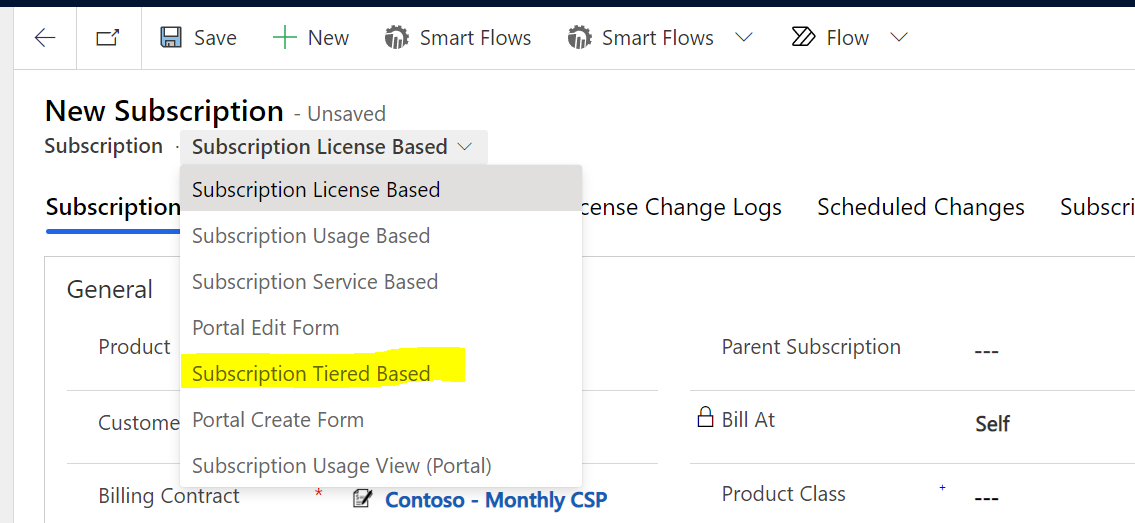Tiered Subscription
Billing for Tiered Subscription is available in the Enterprise Plan
In Work 365, users can create tiered based products which enable SKU to have pricing tiers based on the quantity of a subscription. This gives flexibility with the product pricing in that pricing can increase as the quantity on a subscription increases, or the reverse scenario where pricing can decrease the higher the quantity is on a subscription.
- Before a tiered subscription can be created, it’s important to first create the Tiered Products, and applicable Rate Cards, which will be needed for when the subscription is created.
- Once both the rate card(s) and tiered product(s) are set up as needed, go to a customer’s billing contract, go to the subscriptions tab, and select New Subscription on the right.
- Adding tiered based products is supported on both Recurring and Item Based billing contract types, but from a billing perspective it may make more sense to add tiered subscriptions to an item based contract (especially if billing it annually).
- Once the subscription form is open, be sure to change the form so the “Subscription Tiered Based” form is selected.

- Discard Changes to go to the new form
- Add the tiered product.
- Note the rate card on the right populates by default.
- If there is more than one rate card on the product, users can update this and select a different rate card from the product if that is preferred.
- Add the subscription Quantity and click save
| Name | Display Name | Description |
|---|---|---|
| work365_subscription_linkedsubscription | Linked Subscription | |
| work365_subscription_billat | Bill At | |
| work365_subscription_productclass | Product Class | |
| work365_subscription_billablestatus | Billable Status | |
| work365_subscription_tieredratecard | Rate Card |
Block Rate Cards
- Click on the license change log record to confirm the price was added based on the tiered pricing as set up on the selected rate card on the subscription.

For this example the subscription quantity is 50. Based on the block rate card selected on the subscription, the price point for the current subscription quantity is $699.
Also, because the rate card type is a block rate, that means between quantity 50 and up to and including 99, the price on the subscription is $699.

Essentially the “Block Rate” rate card will apply a specific price point for a group of licenses.
As the quantity of a subscription increases, depending on the tiers of the rate card the pricing will change. In this example, the quantity was increased to a total of 100. This bumps the subscription into the next pricing tier which is a block of 100-249 users at $999.
Thus any the license count on the subscription could be 150, 200, 230, 240, 249, etc, but regardless of the quantity as long as the user count stays within this tier the price for the “block” of users will be at $999. As soon as the quantity goes over the threshold of 249, the next pricing tier would apply 250-x users at y price.
Note from a billing perspective when there are price changes due to an increase of licenses, the following calculations would occur:
Annual Invoice 1: Create lcl for 50 users at $699 annually. Invoice line item would have a full cycle charge for $699
Change log invoice is created later on as a result of the additional licenses added on 6/1/2022.
Given the effective date of the subscription is 5/17/2022, the system would prorate a credit back for 11 months + 16 days for the time the 50 licenses were not used.
Then the system would charge a prorated price for the additional 50 licenses for the period of 11 months + 14 days.
Block Unit Rate Card
On a tiered subscription where the rate card type is block unit rate, this means that as the per user quantity on the subscription changes, the price per unit will vary based on the tiered rates of the rate card.
Below is an example of a Block Unit Rate card. It’s also an example of another pricing model in that as the license quantity increases, the per unit price decreases at the specified tiers.

On the subscription then, let’s say it is created with an initial quantity of 60. In this example the per unit/per user price between 51-60 licenses is $45. 60 x $45 = $2,700.
Then the subscription quantity increases to a total of 80 licenses. At the new price tier of 71-80 licenses, the per unit/per user price is $35. 80 x $35 = $2,800

Also, because the additional licenses were added mid-term, the system would do a prorated credit back for the 60 licenses for the remainder of the term. At the same time the system would do a prorated charge for the additional 20 licenses at the new per unit price.
Updated 5 months ago
